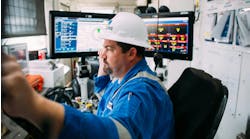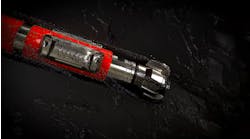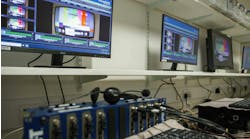TURBINE MAINTENANCE Small droplet technique cleanses entire turbine interior
Stockholm-based Gas Turbine Efficiency (GTE) has recently launched its Industrial range of advanced cleaning systems with three different sized units capable of cleaning all standard-sized turbines. The three units are the GT80 for machines up to 10MW; the GTE160 for up to 45MW; and the GTE400 for up to 250MW.
GTE has already sold four systems for the BP Andrew, Cleeton and ETAP platforms in the North Sea for use on ABB Stal GT35 turbines. "The technology is quite revolutionary," says GTE president Peter Asplund.
The success of the Industrial range has also led to the prototype GTE80 model being bought by Volvo ero Turbines in Malmo last August for use on an industrial VT600 engine.
Formed after a preliminary study of compressor washing procedures within the gas turbine industry, GTE developed its new cleaning method based on the principle of using small amounts of fluid with tiny droplets rather than large amounts of fluid with large drop sizes. The method is based around using surfactants which have negligible environmental impact, unlike abrasives or solvents.
Only 4-9 nozzles
Compared with traditional washing systems, the GTE method is remarkably simple, requiring only four to nine nozzles depending on the turbine size. The same nozzles are used for both on-line and off-line cleaning, thus reducing drastically hardware installation costs.
The nozzles are connected by a small diameter hose to a compact unit which controls the pressure and flow rates. Although bolted to the floor when in situ, the units are extremely portable and can be wheeled into place very easily. They can also be hooked up to the installation's computer system for remote operation.
With small droplet sizes, the hot water/detergent mix is atomized so that it can pass through the same pathway as air and particles. In this way the whole interior of the engine, not just the compressor, is cleaned effectively. Big drop sizes would be thrown out with the centrifugal forces and thus only the periphery of the turbine would be cleaned.
Atomization also reduces the amount of liquids used (by up to 90%) and results in less spillage, so that the cost of transporting and storing water offshore is cut considerably. In tests, the amount of fluid required to clean a big jet engine was reduced from 300 to 30 liters.
Increased turbine efficiency
An important consideration for all gas turbine users is that effective cleaning significantly increases the efficiency of the engine. Energy lost in the form of performance degradation carries with it reduced energy production and substantial revenue losses. The GTE washing system brings the following advantages:
- increased airflow at a given power setting (increased efficiency)
- reduced fuel consumption
- reduced turbine inlet temperatures
- reduction in harmful emissions
- reduced blocking of cooling ducts in turbine blades
- reduced coking in nozzles and combustors (prevents fierce flames, insulation and cracks)
- shorter and `colder' start sequences
- improved stall margins
- reduced vibration levels
- less corrosion.
GTE has also had success in the industrial sector where there is a lot of interest in the company's work on standardization. A large industrial sized GTE400 unit has recently been sold to European Gas Turbines in France for a 75 MW engine.
For more information contact Peter Asplund, Gas Turbine Efficiency: telephone +46 8 760 8550 or fax +46 8 760 8650.
Turbines: the dirty reality
- 1kg of natural gas burned gives off 2.75kg of CO2.
A 25MW turbine consumes around 6,000kg gas/hr.
8,000 hours/year amounts to 48 million kg gas/yr and 132 million kg of CO2/yr - just for one turbine.
Every ton of fresh water costs #1 plus transport costs.
Every ton of detergent costs #15-20,000, plus transport costs.
Using 30-50 liters instead of 1,000 liters results in huge savings.


